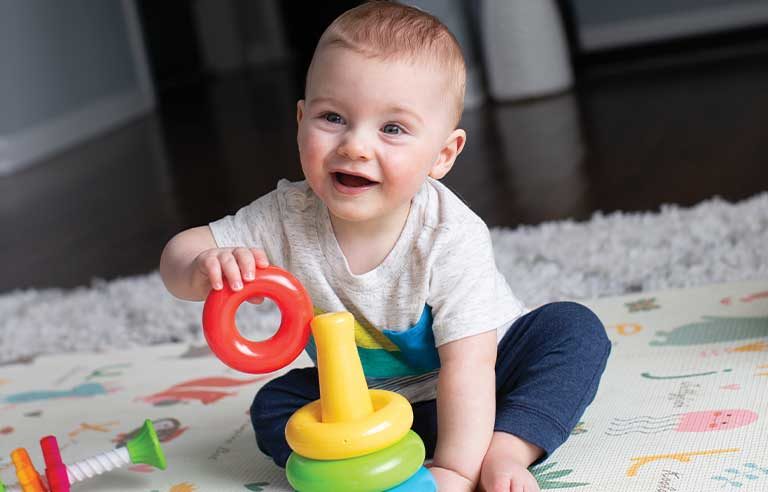Childproofing
Don’t forget about these five hazards

Photo: Scott Nolen
Childproofing goes beyond putting latches on your cabinet doors and corner guards around sharp edges. Before your baby or toddler is on the move, it’s time to take steps. Here are five hazards you don’t want to overlook.
1. TV and furniture tip-overs
Every 30 minutes, a child will visit an emergency room with injuries resulting from tipped furniture or falling TVs, according to the Consumer Product Safety Commission. And, on average, tip-overs lead to the death of one child every 10 days.
To help prevent these incidents, use brackets, braces or mounts on wall straps to secure TVs and top-heavy furniture. These items, available at home improvement and hardware stores, can prevent the weight of the furniture from shifting and possibly tipping over, the CPSC says.
Also, remove tempting items, such as toys and remotes, from on top of TVs, dressers and other furniture.
2. Button batteries
Key fobs, TV remotes, watches and flameless candles are just a few of the items that are powered by button batteries. These batteries can be extremely hazardous to children if swallowed: Every year, more than 2,500 kids are treated in the ER for button battery-related injuries.
“Swallowed batteries burn through a child’s esophagus in just 2 hours, leading to surgery, months with feeding and breathing tubes, and even death,” according to the National Capital Poison Center. Protect young children by keeping button battery-powered items out of sight and reach.
If you believe your child has swallowed a button battery, get to the hospital immediately. On the way there, if you have some in the house, “Give 2 teaspoons of honey only for ingestions that occur within 12 hours and children over 12 months old who can swallow liquids,” HealthyChildren.org advises. “You can give up to 6 doses of honey about 10 minutes apart. If your child vomits, do not offer another dose.”
Don’t attempt to induce vomiting or provide your child with anything else to eat or drink until assessed by a medical professional.
3. Toys
In 2016, about 477 kids were treated in ERs for toy-related injuries. Although most of these injuries were cuts, scrapes and bruises, more serious outcomes can occur, HealthyChildren.org says.
To help prevent injuries, make sure your child only plays with toys that fit his or her age and developmental skills. “Think LARGE,” says HealthyChildren.org. “Make sure all toys and parts are larger than your child’s mouth to prevent choking.”
Don’t forget to read all warning labels carefully. Does the toy shoot into the air? Best to pass on that one – these toys are a common cause of eye injuries. Is it loud? Loud toys can damage children’s hearing. Thoroughly check all toys for small parts or other potential choking hazards such as ribbons and strings before letting your child have it.
4. PoisonKids are curious by nature, so unsecured cabinets and closets can be dangerous for them. Poison Control Centers receive a call about a child getting into a poison every 30 seconds.
Don’t let this happen to your child: Keep your cleaning supplies and other similar household products in a locked or latched cabinet.
Also: laundry detergent pods. These little packets are often bright and colorful, and may look like candy to small children. But, “The packets dissolve quickly when in contact with water, wet hands, or saliva,” HealthyChildren.org says. In 2017, nearly 11,000 calls were placed to Poison Control Centers regarding incidents involving children ingesting laundry detergent pods, and more than 400 children are hospitalized each year after getting into laundry packets.
Store pods in their original, closed container out of the sight and reach of children.
5. Burns and scalds
Did you know? Toddlers as young as 17 months can start a microwave, open the door and remove the contents, says HealthyChildren.org.
“Microwave safety often is overlooked because the ovens are not viewed as dangerous,” Kyran Quinlan, M.D., a member of the American Academy of Pediatrics Committee on Injury, Violence and Poison Prevention, says on the HealthyChildren.org website. “Families need to see that very young children are able to access and open a microwave. It’s one of the biggest ways that kids are burned; some of them are serious burns.”
Splashes from food, spilled hot water or touching a hot item (think microwave popcorn) are just some of the causes of injuries to the more than 320 children treated in ERs every day for burn and scald injuries. Keep hot foods and liquids away from table and counter edges, and supervise or restrict children’s access to the stove, oven or microwave. Never hold a child when cooking at the stove, and store matches and lighters out of reach.
Post a comment to this article
Safety+Health welcomes comments that promote respectful dialogue. Please stay on topic. Comments that contain personal attacks, profanity or abusive language – or those aggressively promoting products or services – will be removed. We reserve the right to determine which comments violate our comment policy. (Anonymous comments are welcome; merely skip the “name” field in the comment box. An email address is required but will not be included with your comment.)
